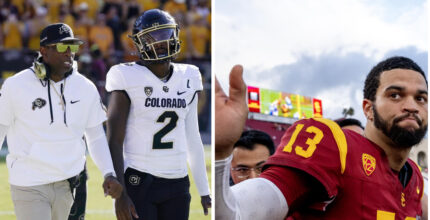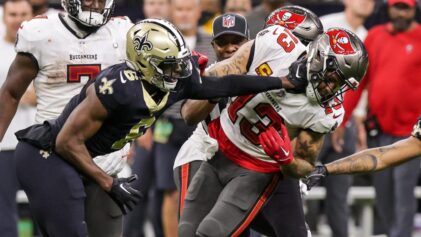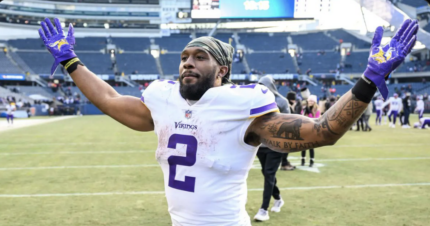The past weekend was Graduation Day for the 2014 class of NFL prospects. Instead of getting diplomas, they took photo-ops with their new employer's hat and jersey on.
Someday we may look back at this draft and know this is where it all went right or wrong for a few teams and coaches. Or we could look like fools for doubting their scouting teams. The NFL Draft was full of iconic and polarizing social moments, however, the essence of the draft is about the gridiron competitors. If the Cowboys had taken Johnny Football with the 16th pick not only would Twitter would have crashed, but the draft could have ended right there. Alas, that did not occur, the San Andreas Fault did not send California drifting into the Pacific, but he still made it onto our list of top-five class of 2014 draft picks. These aren't based in order of talent alone, but include criteria on schematical fit and the need filled by each draftee.
1. Teddy Bridgewater (Minnesota Vikings)
Bridgewater and the Minnesota Vikings were projected to wind up together in multiple mock drafts early in the draft process, however, as Bridgewater’s stock plunged the Vikings interest never waned. Instead, they got their man with the final pick in the first round. Mike Zimmer is a no-nonsense coach and he got a no-frills quarterback to match.
The Browns commissioned a study to determine which quarterback in the draft would be the best in the long haul and Bridgewater emerged as the study’s choice.
Using standardized completion percentage during a quarterback’s final collegiate season as a barometer of the college to NFL transition has proven to be a reliable predictor and Bridgewater aces the exam. The stat gives quarterbacks extra credit for longer passes instead of giving equal percentage points to short passes and bubble screens behind the line of scrimmage. There are a few outliers on the list that turned out to be duds, but it’s an intriguing look at completion percentage that actually factors in the types of passes thrown.
Here are the top six standardized completion percentages from quarterbacks drafted in 2012 and 2013.
|
Russell Wilson |
81.7% |
65.8 |
|
Robert Griffin III |
79.9% |
57.5 |
|
Brandon Weeden |
75.5% |
26.2 |
|
Andrew Luck |
75.2% |
63.8 |
|
Nick Foles |
73.5% |
57.8 |
|
71.5% |
47.8 |
Now peep the 2014 class’ standardized completion percentages during their final seasons.
|
Teddy Bridgewater |
78.3% |
|
Johnny Manziel |
76.7% |
|
Zach Mettenberger |
75.6% |
|
74.2% |
|
|
73.1% |
This doesn’t bode well for Jacksonville fans. Bridgewater also gets the opportunity to begin his career sharing the backfield with the NF's top running back and Cordarrelle Patterson a #84 that resembles Randy Moss.
2. Mike Evans and Austin Seferian-Jenkins (Tampa Bay Bucs)
The Tampa Bay Bucs appear to be rebuilding the Chicago Bears that Lovie Smith was in the middle of assembling before he was abruptly dismissed. Mike Evans’ addition to Vincent Jackson gives the Bucs two long, rangy deep threats similar to Chicago’s Alshon Jeffrey and Brandon Marshall.
They signed former Bear quarterback Josh McCown to compete with Mike Glennon, but Glennon’s deep velocity makes him an ideal starter for the current crop of Bucs wide outs.
The addition of Austin Seferian-Jenkins in the second round also filled a position of need with an ultra-talented tight end with a troubled past and injury concerns. Jenkins is a risk, but his upside is Rob Gronkowski. That’s a risk worth taking in an age where pass-catching tight ends are becoming primary receivers who line up all along the line of scrimmage and offer another mismatch for defenses to worry about.
Evans was the Lord of the Fly Route at Teas A&M and it looks like he’ll be on the receiving end of his fair share of thrown deep balls. The only mystery is from who’ll be throwing to him.
3. Jimmy Garoppolo (Eastern Illinois)
Garoppolo has had one of the best senior seasons and pre-draft evaluation periods we’ve seen in years from an FCS quarterback. It was somewhat inexplicable that he fell into the third round, but naturally Bill Belichick was the first coach to make the decision to pluck the Eastern Illinois quarterback.
Lost in the signing of Garoppolo was this little dig at the difference between the Manning-era Colts and the Kraft-Brady-Belichick Pats.
"Organizationally, in our organization, I don't think we could put together a team the way Indianapolis did it (in 2011)," Belichick said. "They lost (Peyton) Manning and go 1-15 or whatever it was (it was 2-14). I don't think that's what we're working for."
The Patriots have been throwing up a Tom Savage smokescreen for weeks, so it can’t be a coincidence that a former Pats offensive coordinator took the leap. Garoppolo was a better prospect.
As a senior, Garroppolo exploded with a flawless 5,050 yard, 51 touchdown and nine interception campaign, but the offense he ran was somewhat simplistic and rarely featured drop backs. However, he’s more comfortable throwing intermediate passes than Ryan Mallet, who has a howitzer for an arm, but has struggled finding his touch and accuracy on intermediate routes.
4. CJ Moseley (Baltimore Ravens)
Ozzie Newsome has been rerouting his alma mater’s Crimson Tide pipeline into Baltimore during the Saban era, much like did with Miami during the franchise’s primitive seasons. Moseley was the best in an outstanding line of Alabama linebackers that have recently matriculated through the Crimson Tide. Moseley is the other half of Michael Sam's SEC Defensive Player of the Year award. Talent-wise he’s a top-10 rookie, but there were concerns about his injury history and thus he remained underneath the radar. Inside linebackers aren't as sexy as pass rushing outside linebacker pass rushing hybrids such as Khalil Mack, Anthony Barr or Jadeveon Clowney.
Ray Lewis was extremely complimentary of Moseley, who was chosen over safety Haha Clinton Dix, another prospect it was assumed the Ravens would pursue.
“This is a leader at the position of linebacker,” Lewis said, as the Ravens brain trust listened in. “I left there a couple years ago, but when you watch this kid play football, his instinct is what impresses me the most. He’s very patient with his feet, he stays in the pocket and when he gets there. … He’s a read-it-and-react guy.”
Terrell Suggs can handle the north-south pass rushing while Moseley’s focus will be on sideline to sideline blanketing.
5. Johnny Manziel (Cleveland Browns)
How excited is Cleveland about Manziel? A homeless met the Browns owner walking down the street and instead of asking for a job, change or trying to ingratiate himself with a bilionaire, he implored him to draft JFF.
The Manziel pick makes sense for Browns offensive coordinator Kyle Shanahan, whose offenses relied on a litany of rollouts when he was with the Texans before he integrated the zone-read scheme into the Redskins repertoire two seasons ago.
An injury to Nate Burleson’s right pizza-eating arm and Josh Gordon’s potential season-long suspension have cancelled out the elation over Cleveland playing chicken for 21 picks before winding up with their target at No. 22.
That may also be part of the problem. The Browns have drafted terribly since their Cleveland rebirth. Putting Tim Couch aside, this would be the third time they’ve picked a quarterback at No. 22. In 2007, they selected Brady Quinn and in 2012, they chose Brandon Weeden who was 28 going on 29 at the time. For perspective, Quinn is only 29.
Personally, I never thought either one of them had the skillset to be any more than marginal backups in the league and Weeden in particular had bust tattooed all over his bicep. Manziel is high-risk, high-reward. However, I believe he has all the physical traits to become an elite NFL quarterback as long as he avoids the off-field allure of fame during the season and locks in like the other greats who double as overly-prepared nerds during the off-week.
Besides, there’s always the chance that his relationship with LeBron James could benefit the Browns organization as a whole.



